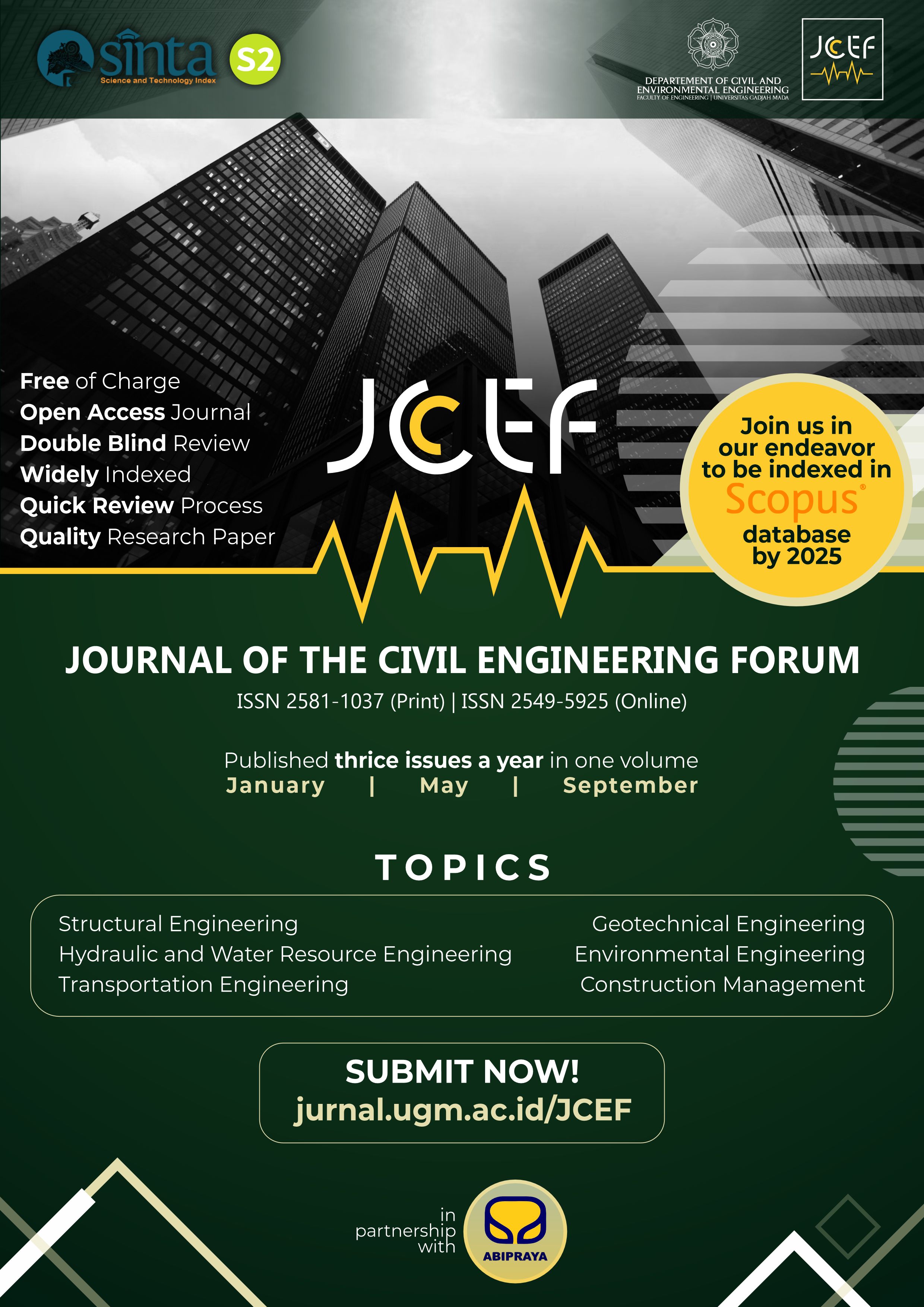Effect of Creep on The Long-Term Deflection of Box Girder Balanced Cantilever Bridge Structure Using B3 Model and CEB 2010
Abstract
Creep significantly affects the long-term deflection of the prestressed concrete bridge structure. Some models often used in predicting creep do not consider the water-cement ratio. The water-cement ratio is a factor in the magnitude of creep. If the water-cement ratio is excessive, the creep will also be significant. B3 Model uses the water-cement ratio in predicting creep in prestressed concrete bridge structures and has provided good accuracy with measured deflection data. This study compares B3 Model with Model CEB 2010 to predict the effect of creep on the long-term deflection. The author modeled the bridge structure using Midas Civil 2022 v1.2 software by utilizing the construction stages analysis facility to idealize the balanced cantilever and the effect of creep on the long-term deflection. Envelope displacement of bridge B3 Model is more significant than CEB 2010. The prediction deflection of the B3 Model in 100 years of service life of the bridge is -16.34 cm, while CEB 2010 is -11.90 cm. Creep affects total deflection by 84% to 88%. Creep affects the deflection significant because, in the construction process, each box girder segment is stressed and loaded at the age of 3 days. At the age of 3 days, the elastic modulus of the concrete is still not entirely, and the cement paste on the concrete is still in the hydration process. The results showed a significant difference between B3 Model and CEB 2010. B3 Model predicts that the long-term deflection of the bridge until the end of the bridge's service life is 44% to 49% greater than the CEB 2010 model. Prediction of total deflection until the end of 100 years of bridge service life does not exceed the limit determined by SNI and CEB codes.
References
Akbar, S. and Carlie, M. (2021), ‘Long-term deformation of balanced cantilever bridges due to non- uniform creep and shrinkage’.
Atrushi, D. S. (2003), Tensile and compressive creep of early concrete: testing and modelling, Fakultet for ingeniørvitenskap og teknologi.
Bazant, Z. P. and Baweja, S. (2000), ‘Creep and shrinkage prediction model for analysis and design of concrete structures: Model b3’, ACI Special Publications 194, 1–84.
Bažant, Z. P., Yu, Q. and Li, G.-H. (2012), ‘Excessive long-time deflections of prestressed box girders. i: Record-span bridge in palau and other paradigms’, Journal of Structural Engineering 138(6), 676–686. URL: 10.1061/(ASCE)ST.1943-541X.0000487
Brooks, J. (2005), ‘30-year creep and shrinkage of concrete’, Magazine of concrete research 57(9), 545–556. Committee, A. C. et al. (2008), ‘Guide for modeling and calculating shrinkage and creep in hardened concrete. aci committee 209 (aci 209.2 r-08), american concrete institute, farmington hills, mi’.
Elbadry, M., Ghali, A. and Gayed, R. B. (2014), ‘Deflection control of prestressed box girder bridges’, Journal of Bridge Engineering 19(5), 04013027.
Gamnitzer, P., Brugger, A., Drexel, M. and Hofstetter, G. (2019), ‘Modelling of coupled shrinkage and creep in multiphase formulations for hardening concrete’, Materials 12(11), 1745.
Giaccu, G. F., Solinas, D., Briseghella, B. and Fenu, L. (2021), ‘Time-dependent analysis of precast segmental bridges’, International Journal of Concrete Structures and Materials 15(1), 1–21.
Nawy, E. G. (2000), Prestressed concrete. A fundamental approach, number third Edition.
Niken, C., Elly, T., Supartono, F. and Laksmi, I. (2018), Deformation of high performance concrete plate under humid tropical weather, in ‘IOP Conference Series: Materials Science and Engineering’, Vol. 316, IOP Publishing, p. 012036.99 Journal of the Civil Engineering Forum Vol. 9 No. 1 (January 2023)
Vokunnaya, S. S. and Tanaji, T. (2017), ‘Construction stage analysis of segmental cantilever bridge’, International Journal of Civil Engineering and Technology (IJCIET) 8(2), 373–382.
Waskita Karya Inc (2011), ‘Construction method. balance cantilever cycle time work 1 segment box girder’.
Yoon, Y.-S., Choi, H.-T. and Kwon, S.-B. (1999), ‘Time-dependent material properties in fcm segment of prestressed concrete box-girder bridge’, KCI Concrete Journal 11(3), 99–107.
Copyright (c) 2023 The Author(s)

This work is licensed under a Creative Commons Attribution-ShareAlike 4.0 International License.
Copyright is granted to authors for the purpose of providing protection for articles written to describe experiments and their results. JCEF will protect and defend the work and reputation of the author and are also willing to address any allegations of violation, plagiarism, fraud, etc. against articles written and published by JCEF. JCEF is published under the terms of the Creative Commons Attribution-ShareAlike 4.0 International License (CC BY-SA 4.0). The author holds the copyright and assigns the journal rights to the first publication (online and print) of the work simultaneously.




